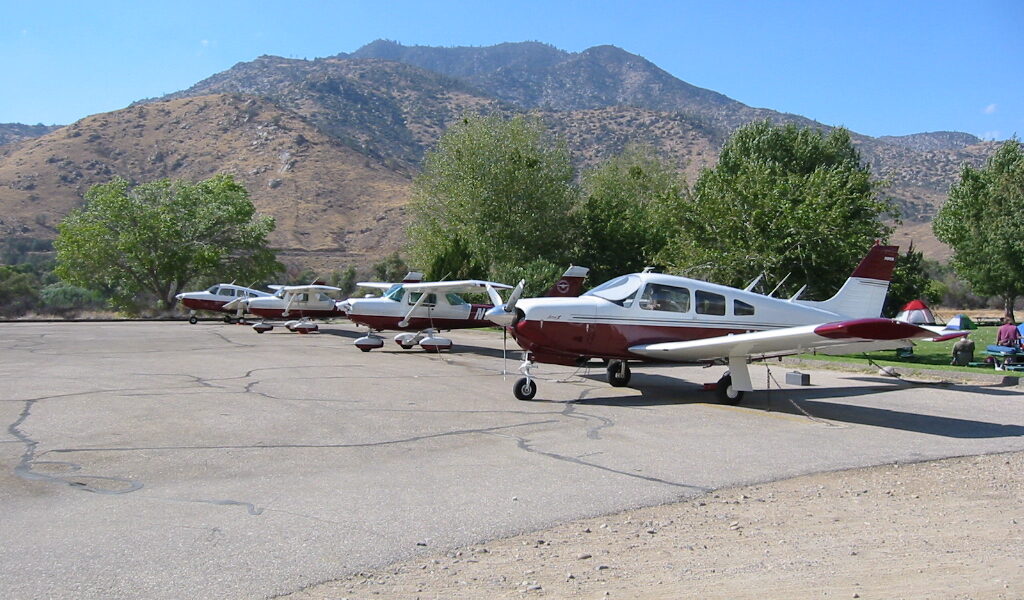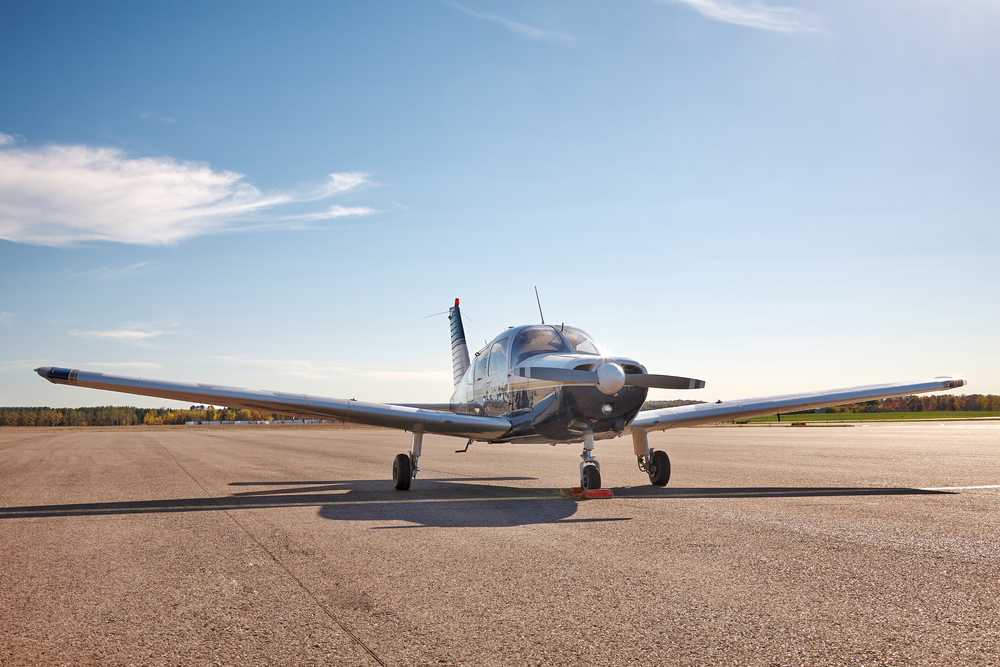Kern Valley Airport sits in the southern Sierra Nevada foothills serving the little town of Kernville, California. This public-use airport combines mountain scenery with reasonable access, making it popular for weekend getaways and training flights. The 3,237-foot paved runway at 2,614 feet elevation handles most GA planes while getting you into outdoor recreation around Sequoia National Forest.
Quick Answer: Kern Valley Airport (L05) has a 3,237-foot paved runway at 2,614 feet elevation in central California. Runway 15/33’s got a slight gradient (1.8% uphill to the south). Facilities include self-serve 100LL, tie-downs, basic amenities. Town of Kernville’s 1.5 miles away. Weather’s VFR most days with occasional strong winds. Public-use airport, no landing fees. Contact: (760) 376-2629. Best for pilots with 150+ hp planes and mountain flying awareness.
The Runway
Single runway (15/33) measures 3,237 feet long and 50 feet wide. Paved asphalt in good condition. Elevation’s 2,614 feet, so you gotta consider density altitude during summer. Runway has about a 1.8% gradient uphill to the south. That modest slope helps southbound landings and northbound departures but doesn’t dominate ops.
Both ends have clear approaches with reasonable obstacle clearance. Trees line the western boundary. Kern River flows along the eastern side. Mountains rise on all sides – typical Sierra foothill terrain. Pattern altitude’s 3,600 feet MSL. CTAF’s 122.9 for pilot-to-pilot advisories. No tower or weather reporting. Ramp accommodates 15-20 planes with tiedown spots available.
Fuel and Services
Self-serve 100LL’s available 24 hours via credit card. Fuel prices typically run $1-$2 above metro airports due to remote location. Check current prices before you show up to avoid surprises. No full-service fuel – you’re pumping your own. Fuel system’s well-maintained and reliable.
Basic amenities include restrooms and a pilot lounge. No maintenance on-field – nearest A&P’s in Bakersfield (30 miles south by road, 20 by air). Tie-down ropes are provided but bring your own chains and chocks. No hangars for transient planes. Can’t camp on the airport. Town of Kernville’s got restaurants, lodging, supplies accessible by walking or taxi.
Landing Here
Standard patterns are left for Runway 15, right for 33. Wind typically flows along the valley, favoring northerly or southerly ops. Overfly at 500 feet above pattern altitude to check the sock and traffic. Enter 45 to the downwind. Monitor CTAF for other traffic.
Afternoon thermals and mechanical turbulence are common in summer. Morning flights offer calmer conditions. Terrain channels winds, sometimes creating challenging crosswinds. Expect bumps on final during midday heating. Landing distances are reasonable – most planes stop in 1,500-2,000 feet. Slight upslope to the south helps deceleration on Runway 15. Runway 33 benefits from downslope acceleration on departure.
Departures
Calculate density altitude before departure, especially summer afternoons. Temps over 90°F push DA to 5,000-6,000 feet. A 172 with 160 hp at gross needs about 2,000-2,500 feet at these DAs. The 3,237-foot runway provides decent margins for properly-loaded planes.
Morning departures offer way better performance. Use full runway length for all takeoffs. Abort capability drops past mid-field – if you’re not flying by 1,800 feet, abort and reassess weight or conditions. Climb away from the airport before turning – ridges on both sides create terrain concerns. Follow the valley initially to gain altitude before crossing ridges. Watch engine temps carefully during extended climbs in high DA.
Weather
Kern Valley enjoys VFR weather most of the year – 300+ flyable days annually. Summer brings hot, dry conditions with DA challenges. Temps regularly exceed 95°F creating DAs of 6,000+ feet. Afternoon thunderstorms develop occasionally during monsoon season. Winter weather’s mild compared to higher Sierra elevations but occasional rain and low ceilings happen.
Wind’s the primary weather challenge. Spring brings strong winds exceeding 25 knots regularly. Gusty conditions and mechanical turbulence from terrain make spring flying tough. Fall offers the best weather: cooler temps, light winds, excellent vis. No weather reporting at L05 – monitor nearby airports (Bakersfield, Porterville) for regional trends. Always call the airport manager or local FBO for current local conditions.
What’s in Town
Kernville’s a small town (population 1,400) catering to outdoor recreation. Kern River provides world-class whitewater rafting and kayaking. Fishing in the river and Lake Isabella (5 miles south) is excellent. Hiking trails access Sequoia National Forest. Mountain biking’s popular on nearby trails. Several restaurants serve the tourist crowd.
Accommodations include motels, vacation rentals, campgrounds. Town’s 1.5 miles from the airport – walkable but long on hot days. Local shuttle services exist but aren’t always reliable. Consider renting a car or arranging rides ahead. Lake Isabella offers additional restaurants, lodging, water sports. Area attracts visitors escaping urban California heat while enjoying mountain scenery.
What to Fly
Most GA planes handle Kern Valley comfortably. Typical visitors include 172s and 182s, Piper Cherokees and Arrows, Mooneys, Bonanzas. Minimum recommended HP’s 150, though 180 provides better margins in summer. Paved runway accommodates nosewheel and tailwheel equally. High-performance singles and light twins operate regularly.
Calculate weight and balance carefully. The DA, runway length, and terrain require performance margins. Avoid max gross in summer. Reduce passengers or fuel if necessary. The 50-foot runway width’s narrower than most training airports – practice centerline control before visiting. Crosswind limits matter here – 15+ knot crosswinds are common in spring.
Safety
While Kern Valley’s more forgiving than high-altitude backcountry strips, it still demands mountain flying awareness. Terrain, DA, and weather variability require proper planning. Don’t make Kern Valley your first mountain airport – build experience at easier locations first. Review mountain flying techniques including DA effects, wind patterns, emergency procedures.
Always have fuel reserves for diverting to Bakersfield if weather deteriorates. Valley can fill with smoke from wildfires – check air quality before departure during fire season. Strong winds can make ops unsafe – be conservative with personal minimums. File a flight plan and update it on arrival. Carry survival gear appropriate for Sierra Nevada conditions. RAF (Recreational Aviation Foundation) and AOPA provide excellent mountain flying resources. Kern Valley offers a great introduction to mountain flying with the safety margin of a paved runway and readily available fuel.



Leave a Reply